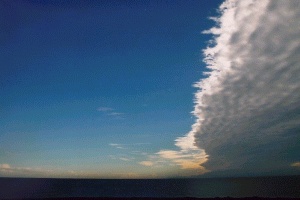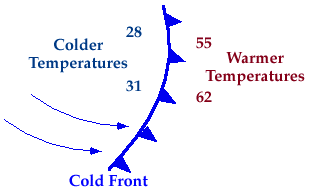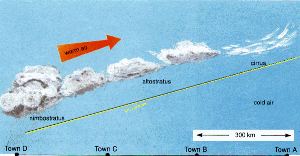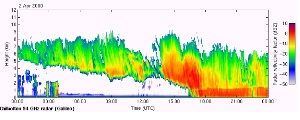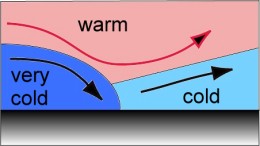 > English > Climate Encyclopaedia > Weather > basics > 1. Weather & Fronts > - Fronts
> English > Climate Encyclopaedia > Weather > basics > 1. Weather & Fronts > - Fronts
|
WeatherBasics |
FrontsA weather front is defined as the boundary between two airmasses of different temperatures and densities. When two airmasses meet, the warmer air rises above the cooler denser air. The transition region between the two airmasses is known as a front.
|
|
Weather fronts generally travel from west to east. Their direction can, however, be affected by geographic features such as mountains and large bodies of water, particularly if they form in the lower levels of the atmosphere.
|
Fronts are always accompanied by clouds and, very often, also by rain. When a weather front passes over an area, changes in wind speed and direction, atmospheric pressure and the moisture content of the air are also seen. There are four types of fronts: cold fronts, warm fronts, occluded fronts and stationary fronts. The type of front depends both on the direction in which the airmass is moving and on the characteristics of the airmass.
|
|
Cold frontsCold fronts occur when a colder air mass replaces a warmer one. At a cold front, the cold air is behind the warm air. Because the cold air is more dense, it pushes the warm air out of its way, forcing the warm air to rise into the atmosphere.
|
3. Image right: A cold front is represented by a solid blue line with triangles along the front pointing towards the warmer air and in the direction of movement (temperature is given in Fahrenheit in the figure.) Source: University of Illinois http://ww2010.atmos.uiuc.edu/(Gh)/home.rxml |
|
Warm frontsWarm fronts occur when a warm airmass approaches a colder one. The warmer air lifts up and over the colder air. Warm fronts generally move more slowly than cold fronts, gently settling over the cold air and moving it out of the way. Rain associated with warm fronts is less heavy but more extensive (300 to 400 km) than rain generated at cold fronts.
|
|
The air behind a warm front is warmer and more moist than the air ahead of it. Warm fronts generate light rain or snow which can last from a few hours to several days. When a warm front passes through, the air becomes noticeably warmer and more humid than it was before.
|
The first signs of the warm front are the cirrus clouds, followed by the cirrostratus, altostratus, nimbostratus and stratocumulus types of clouds. The cirrus clouds can be up to 1000 km away from the position of the front at the ground. These clouds are all generally horizontal in structure because the front slopes gently into the air. Clouds associated with cold fronts are mostly vertical in structure because the front rises quickly.
|
|
|
6. Picture on the left: A warm front is represented by a solid red line with semicircles pointing towards the colder air and in the direction of movement (temperature is given in Fahrenheit on the figure.)Source: University of Illinois http://ww2010.atmos.uiuc.edu/(Gh)/home.rxml
|
Occluded frontOccluded fronts occur when cold, warm and cool air come together. There are two main types, cold and warm occluded fronts. The difference depends on the relative states of the cold airmasses behind and in front of the warm air. Cold occluded fronts occur when a very cold front overtakes a warm front. The cold front lifts the warm front up in to the air (both the warm air above and the cold air underneath) and the cold front creeps underneath. At the beginning the weather is similar to that seen when a warm front passes, but it then changes into typical cold front weather and heavy rain falls.
|
|
Warm occluded fronts occur when a cold front overtakes a warm front overlying a very cold front. Here the cold front and the warm front both move up and over the very cold front which stays close to the ground. The weather is similar to that when a warm front passes. Stationary fronts form at the boundary between warm and cold air when neither airmass is moving forward. They have similar characteristics to warm fronts but are less active.
|
|
|
About this page:author: Vera Schlanger - Hungarian Meteorological Service
|
Further reading:http://www.ckkc.co.uk/html/stories/metrolgy.html
|

